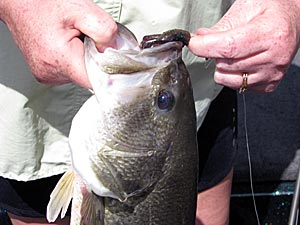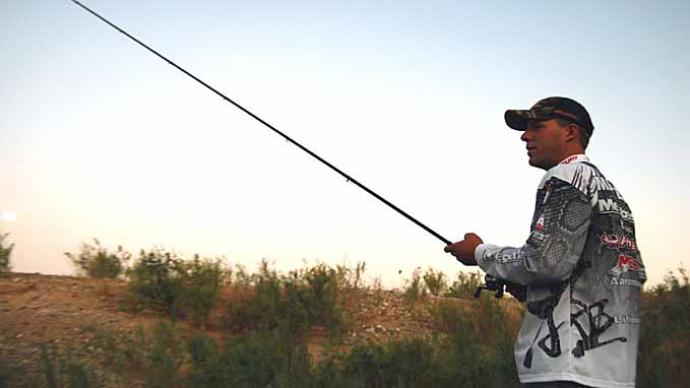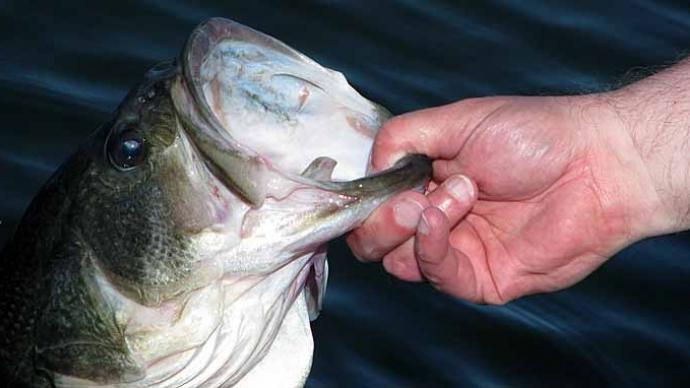
To be a good tournament angler, you must be versatile. You have to be able to go from one lake to another and be able to catch fish in all conditions and types of cover. One of the most abundant types of cover is weeds (or grass). Grass can be found all over the country in most of the lakes we fish. Although grass will hold fish all season long, the best time to fish deep grass is right during the warmest months of the year. June through August, this can be a dynamite way of catching big summer bass.
There are many types of grass, but the types we are most often looking for in deep water are hydrilla, milfoil, and coontail. Hydrilla is predominately in the south with coontail and milfoil all over the country. The latter two are the main forms of vegetation in the sandy and muddy lakes near my home up north.
The best grass you can fish will most often be the greenest grass you can find because it produces more oxygen than dead or dying grass. Aquatic plants produce oxygen through photosynthesis, which is the process by which plants "inhale" carbon dioxide and "exhale" oxygen. Aquatic vegetation is the only type of bass cover that does this. Photosynthesis takes place with the help of sunlight. When the oxygen level peaks and activity in the lake peaks, so does the bass' feeding activity. This is one reason fishing deep weeds is often best on bright sunny days.
Some of the best places to fish are areas where multiple types of weeds are present. An abundance of different types of weeds offers the fish more types of forage and more hiding opportunities. Weeds also provide a food base for baitfish, and offer baitfish a place to hide.
Grass can sometimes cover miles upon miles of water. So where do you fish? Grassbeds can be divided into two, high-percentage areas: the inside edge and the outside edge. Early in the year bass are more often on the inside edge of the weeds slowly working their way to the outside edge as the temperature warms.
The wind is a key contributing factor in positioning the bass as well. I have found that a strong wind will often move bass shallower and make them more active because it stirs up more oxygen which disperses baitfish, although it does make boat positioning and the overall presentation more of a chore for the angler.
Within each area, there are many other smaller spots to key in on. You should approach a stretch of weeds just like you would any bank on the lake. Points, pockets, isolated clumps, and any irregularities are all key areas. However, you still cannot rule out the straight edges. Also, the grass you cannot see deserves some extra attention as well. With all of the anglers out there pounding the weedlines, many of the big bass will move out into some of the deeper submerged grass that you have to locate with your depthfinder.
Keep an eye on your sonar for any other cover present within the grass. Such as rock piles or wood. Another thing to look for on your electronics is structure changes such as humps, ditches, troughs, points, or a change in bottom composition. This is why it is very important to use a flasher. With today's three-color flashers it is easier than ever to find these small intricacies. When setting the gain on a flasher just right, you can distinguish other cover and even fish within the weeds. This is key to finding that tournament-winning honey hole.
GPS is also important. Many times when fishing deep grass you are fishing in a crowd. Rather than tossing out a marker buoy and attracting unwanted attention, you can simply push a button on your GPS to stay on target. Also, it is essential to get back to the spot within the spot. Like that rock pile you found or the hump or ditch that has been holding fish for weeks, months, or even years. During the competition, you do not have time to idle around for sometimes hours or even be beaten to the spot.
When fishing the grass, the biggest problem fishermen make is casting too far. Short pitches make it much easier to control your bait, feel bites and get the fish to the boat.
Another mistake most anglers make is moving on down the bank after they have caught a fish. The fish are done spawning and are in their summer haunts. This means they are often schooled up. So, when I catch a bass I like to throw out a marker buoy and really work over the area. If the bite slows down in one area do not be afraid to switch up lures or techniques. Or even in some extreme cases I have left the area completely but did not pull up my marker. Continue down the weedline and then return back and many times the fish have regrouped and will bite again.
As with all fishing techniques, the proper equipment is required. I like long, powerful rods. When I am fishing deep grass, I opt for two rods. One is a Kistler Helium LTA 7 foot 11 inch heavy rod coupled with a Daiwa Advantage 150H reel with a 6.3:1 gear ratio spooled up with 50-pound Spiderwire Stealth. I use this setup for dirtier water and thicker grass. The second setup is a Kistler Helium LTA 7 foot 6-inch rod also paired with a Dawa Advantage 150H reel, this time spooled with 16 pound Gamma Edge Fluorocarbon line. Fluorocarbon is very important when fishing in the grass because of the low stretch and high abrasion resistance. I like Gamma because it is the strongest and most supple line I have found. So, I can downsize my line from normally flipping 20 to 25-pound test down to 16. When the fishing is really tough or I am fishing in a crowd I will occasionally downsize as far as to 12-pound test. Having a good quality rod is also very important. It is essential to have enough tip to get your lure in the tiniest holes in the grass but have enough backbone to pull giant bass out of the nastiest cover in the lake.
When choosing lures I like to start with a jig because it will often catch larger bass than other baits. I usually start with a 5/16 ounce to 7/16 and will upsize or downsize if necessary to fight the wind or a tough bite. I usually opt for a homemade jig with an Arkie-style head, though I will also often use Rattleback, Strike King, and Booyah jigs as well. I usually try to match my colors to the tint of the water and the coloration of the forage. Usually, shades of green and brown do the trick, such as pumpkin, green pumpkin, watermelon, motor oil, and the old standby black and blue. I use many different trailers for my jigs dictated by the mood of the fish. The best all-around trailer is the Zoom Super Chunk, but when the bass are being finicky I like to use the Yum Chunk because it is loaded with salt and the patented Yum fish attractant. When bass are active I love using the Paca Chunk by Netbaits. The claws swim and vibrate behind the jig when it is being pulled.
When bass will not take jig I will select a tube or a Reaction Innovations Sweet Beaver. The tube is a great bait that I have been using for years now, but the beaver is something I have just caught onto recently. It seems to be the closest plastic I can find to producing the size bass a jig will catch without sacrificing numbers. Again I like to keep it simple with colors. Mostly browns greens and blues. With sprayed grass and black and blue being my two confidence colors.
While a very small percentage of time is actually spent catching the fish, it is, however, a great way to beat the heat and catch a tournament-winning bag.




